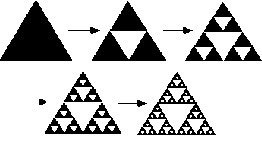Introduction
to Fractal Geometry
Problem
Statement
This
week’s group task involves three tasks centered on the concept of
fractals. First, we are to create a
fractal using MSW Logo and/or Geometer’s Sketchpad. Secondly, we are to represent the area and perimeter of that
fractal both literally and analytically; and finally, we are to write a lesson
plan that develops the analysis of these features of the fractal for upper
level high school students.
Key Mathematical Concepts
Create a fractal…
We created the following fractal
using MSW Logo. It is a variation on
the hat curve, dividing each segment of a square into fourths, then drawing a
convex hat on the second fourth of the segment and a concave hat on the third
fourth of each segment. Below are
sketches of the first 4 levels generated by Logo. The sketches are not drawn using the same scale, but are resized
to fit well on this page. The previous
curve in each sketch is shown in blue.
The code that generates this fractal is attached in a file named
mod_hat.lgo and is also shown below the following figure.




1st level 2nd
level 3rd
level 4th
level
to curve :n
ht
make "x 1
repeat :n [make "x 4*:x]
make "l 200/:x
repeat 4[ifelse :n=0 [fd :l][line :n :l] rt 90]
end
to line :n :l
ifelse :n=1 [fd :l lt 90 fd :l rt 90 fd :l rt 90 fd
:l fd :l lt 90 fd :l lt 90 fd :l rt 90 fd :l][line :n-1 :l lt 90 line :n-1 :l
rt 90 line :n-1 :l rt 90 line :n-1 :l line :n-1 :l lt 90 line :n-1 :l lt 90
line :n-1 :l rt 90 line :n-1 :l]
end
Analyze the fractal…
Below you will find an illustration that
takes a single side (segment) of the square used to start our fractal and then
shows what occurs from that initial level (called level 0) to the following
level (this is called the 1st iteration). The illustration was created by Sketchpad; the file named
curve1.gsp is attached. Then following
that illustration are descriptions of the analyses we did of the area and
perimeter characteristics of this fractal as well as the Excel charts
summarizing the information for specific iterations. The Excel file named FractalAnalysis.xls is attached.

…Analysis of Perimeter…
We
will start our analysis by looking at perimeter. Perimeter is a function of the length of the sides of a figure,
so we will begin by looking at the segments that make up those sides. Geometrically, the sketch above shows that
during the 1st iteration the number of segments making up one of the
four sides of our “square” increases from one to eight segments. The Logo code above demonstrates this on
line 2 of the “to line” definition. Specifically, the first set of brackets following the ifelse
command is responsible for turning one segment into eight. Since one segment becomes eight, the final
result is that after each progressive level of iteration our figure is going to
have eight times as many segments as it had in the previous level. Analytically, this can be expressed in
general terms for the nth level of the fractal:
Total Segmentsn = ![]()
You can also note from the sketch that our
initial segment AE has a length of four inches. Furthermore, the figure in the level 1 is
made up of one-inch segments. If we
continued this illustration to level 2, we would be able to note that it was
made up of ¼-inch segments. Therefore,
segments in the 2nd level are ¼ the length that they were in the 1st
level and segments in the 1st level are ¼ the length that they were
in level 0. So for any particular level
(iteration), each new segment generated is ¼ the length of each segment in the
previous level. (This is a recursive
definition.) This definition can be
expressed explicitly, too, by comparing each iteration back to the initial
level. If level 0 is L
units long, then level 1 is ¼ of L, level 2 is ¼ of ¼ of L
(1/16 of L ), and so on. Since this pattern continues for all consecutive iterations, it
allows us to predict a segment length at the nth level using an
equation based on an initial segment of length L:
Length of Segmentn = ![]()
In determining the perimeter of our figure
as it goes through each additional level, we noted above that a segment in the
initial level is L units long.
Due to the fact that our figure is a square at this initial level, you
simply need to multiply the length of the level 0 segment by four to represent
four congruent sides. This leads to the
value of 4L. In the level 1 each
segment is only ¼ the length of the
initial level. However, there are eight
times as many segments making up level 1.
Therefore, if we multiply the length of a segment found in this level by
the number of segments making up our modified “square,” we find that our
perimeter for this second level is L/4 * 8segments * 4sides = 8L. If we were to continue on to the next level,
we would find that even though the segments making up the figure are only a
1/16 of the original segment’s length, there are sixty-four times as many
segments available to contribute to the figure’s perimeter as were found in the
initial level. This would contribute to
the value of 16L that we calculated (1/16L * 64segments * 4sides). This pattern continues throughout each
consecutive level and allows us to derive the perimeter of our figure with an
initial segment length of L at the nth iteration with the
equation:
Perimetern = ![]()
This
Excel chart summarizes 10 iterations and their corresponding segments, lengths,
and perimeters as discussed above.
|
N iterations |
Total Segments |
Segment Length |
Perimeter |
|
|
|
|
|
|
0 |
8^0(4) = 4 |
L/(4^0) = L |
(2^2)L = 4L |
|
1 |
8^1(4) = 32 |
L/(4^1) = L/4 |
(2^3)L = 8L |
|
2 |
8^2(4) = 256 |
L/(4^2) = L/16 |
(2^4)L = 16L |
|
3 |
8^3(4) = 2048 |
L/(4^3) = L/64 |
(2^5)L = 32L |
|
4 |
8^4(4) = 16384 |
L/(4^4) = L/256 |
(2^6)L = 64L |
|
5 |
8^5(4) = 131072 |
L/(4^5) = L/1024 |
(2^7)L = 128L |
|
6 |
8^6(4) = 1048576 |
L/(4^6) = L/4096 |
(2^8)L = 256L |
|
7 |
8^7(4) = 8388608 |
L/(4^7) = L/16384 |
(2^9)L = 512L |
|
8 |
8^8(4) = 67108864 |
L/(4^8) = L/65536 |
(2^10)L = 1024L |
|
9 |
8^9(4) = 536870912 |
L/(4^9) = L/262144 |
(2^11)L = 2048L |
|
10 |
8^10(4) = 4294967296 |
L/(4^10) = L/1048576 |
(2^12)L = 4096L |
|
|
|
|
|
|
N |
(8^n)*4 |
L/(4^n) |
(2^(n+2))*L |
Finally, as we look at the perimeter of the
fractal after an infinite number of iterations, we can conclude that the
perimeter increases without bound.
![]()
…Analysis of Area…

Now we will analyze the area of the
fractal. Geometrically, the sketch
above allows us to determine how many squares are added and subtracted for
this, the first iteration. It can be
seen that for every segment of the original blue square, there is a new square
added to the outside and another square taken away from the inside. Since the original figure (level 0) has 4
segments, there is a total of 4 squares added to the outside and 4 squares of
equal size missing from the inside of the next figure (level 1). Due to the “convex” and “concave” nature of
each subsequent iteration, we are in a sense adding a square and then taking
away a square for each segment of the previous figure. Therefore, all iterations add and subtract an
equivalent number of squares. This
helps make this constructive property task fairly trivial. The number of squares being added and
subtracted at the nth iteration is dependent on the number of
segments at the (n-1)th iteration.
Therefore, we can utilize our results for the number of segments above
and write the equation:
![]()
Due
to the fact that for every square that is added to our figure, there is another
square of equivalent area that is being subtracted from it as well, it stands
to reason that we will not be adding any area to our figure throughout our
transformations. Analytically, if the
area of the original square is assumed to be one square unit, the additional
area contributed by the nth-iteration is also given by the following expression
and results in an unchanged area.
![]()
The
sum of the areas of all such contributions plus the area of the original square
is given by the expression:
|
N |
Segments |
Squares Added |
Additional Area |
|
|
|
|
|
|
0 |
4 |
|
|
|
1 |
32 |
32*1-32*1 |
0 |
|
2 |
256 |
256*1-256*1 |
0 |
|
3 |
2048 |
2048*1-2048*1 |
0 |
|
4 |
16384 |
16384*1-16384*1 |
0 |
|
5 |
131072 |
131072*1-131072*1 |
0 |
|
6 |
1048576 |
1048576*1-1048576*1 |
0 |
|
7 |
8388608 |
8388608*1-8388608*1 |
0 |
|
8 |
67108864 |
67108864*1-67108864*1 |
0 |
|
9 |
536870912 |
536870912*1-536870912*1 |
0 |
|
10 |
4294967296 |
4294967296*1-4294967296*1 |
0 |
|
|
|
|
|
|
n |
4*8^n |
4*[8^(n-1)]-4*[8^(n-1)] |
0 |
Taking
the limit of this expression as n goes to infinity yields

We
can see through this analytical approach that it supports what we concluded
geometrically; there is no change in area.
In conclusion, while the
perimeter of our fractal becomes infinitely large after an infinite number of
iterations, its area is not affected by any number of iterations.
Write a lesson plan…
Overall
description:
The students will investigate fractals in
small groups and individually. It is
assumed the students are on the 11th or 12th grade level
and have been introduced to the concept of self-similarity at a previous
time. The students have the needed
technology skills to use the software/calculators described in this lesson. This lesson could serve as an
application/review of sequences and series or as a stand-alone section on
analyzing patterns.
Time
Frame:
2-3 50-minute periods or 1-1½ blocks
(includes assessment, but not the extended assignment).
Objectives:
1) Each student will be able to verbally and accurately describe the
generator of a fractal.
2) Each student will use inductive reasoning to discover patterns in
area and perimeter of the fractals and use those patterns to find the area or
perimeter of any level of a fractal.
3)
Each student
will derive algebraic formulae to express the area and perimeter of the nth
level of iteration of a fractal.
4)
Each student
will have opportunity to apply what they have learned through an extension
topic using the graphing calculator.
Introductory
discussion (Anticipatory Set):
The teacher will review the concept of
self-similarity. The anticipatory set
handout is attached in a file named AntSet_SelfSim.doc and is included in print
form at the end of this lab report. The
term recursion will be introduced or reviewed as needed. Analogous examples to help students
understand might include looking in a mirror while holding a mirror or taking a
picture of someone taking a picture of you taking a picture of them… The teacher should point out or have
students point out weaknesses to the analogy, such as reflections grow smaller
overall while fractals do not necessarily do so.
Modeling
of concept:
The teacher will model generating 2-3 iterations of a fractal using Koch’s snowflake. This can be done with MSW Logo (the Logo file is attached as koch.lgo) or the Geometer’s Sketchpad or by hand using an overhead projector or chalkboard. He/she will guide the students to understand what is being asked when the activity sheet says to “verbally describe the generator” and “investigate area and perimeter”. No development of formulae will take place in the modeling stage, as discovery is the purpose of the exploration.
Exploratory
activity:
The students will work in pairs or small groups using MSW Logo or Geometer’s Sketchpad to generate different fractals. The fractal introduced above (modified hat fractal, attached as mod_hat.lgo) will serve as the initial investigation. Files will be provided that include the programs or scripts needed for students to choose at least one additional fractal to investigate. (Right now there are 3 files listed from which to choose; ideally there would be 4 or 5.) The emphasis of this exploration is determining area and perimeter relationships in fractals both recursively and explicitly. The software will also assist students in giving verbal descriptions of the fractal generator. An activity sheet will assist the students in organizing the information they discover during the exploration. This sheet is attached in a file named Fractal_Explore.doc and is included in print form at the end of this lab report.
Assignment:
The students will receive a take-home
assignment including 2 fractals to analyze individually (similar in nature to
those done in the group session) as well as specific iterations to evaluate for
given formulae. Students will also be
asked to describe in writing the fractal generator of the 1-2 fractals analyzed
as well as be prepared to give an oral description in class. As a challenge
assignment, students can be encouraged to generate their own fractals using
software if available or graph paper if not.
The take-home assignment sheet is attached in a file named
Fractal_TakeHome.doc and is included in print form at the end of the lab
report.
Assessment:
In-class group work (objectives 1-3): This portion of the lesson will be worth 25 points. The teacher will listen for and log examples of constructive participation during the activity. Points will be assigned for participation as follows:
Minimal--present, but no meaningful contributions = 10 pts
Average--follows directions doing the very least possible = 15 points
Above average--meets all requirements = 20 points
Superior--exceeds requirements, initiates additional investigations = 25 points
Take-Home assignment (objectives 1-3): This portion of the lesson will be worth 50 points. Students will contract for the grade they wish to attain as follows:
C—correctly complete guidelines listed on handout for 2 fractal patterns
B—complete C grade requirements plus create and analyze 1 original fractal
A—(includes objective 4) complete B grade requirements plus complete the Extension handout (the extension assignment is due at the beginning of the 4th class period following the completion of the exploration).
In a class session following the completion of the exploration and take-home assignment, students will be asked to give an oral description of a fractal to the class (or group within the class). The group will attempt to draw the fractal from the description given. Group drawings will be used to assess the student’s success; this portion will be worth 10 points. A short class discussion as well as written work will be used to assess those students who chose to complete the extension assignment, thus giving the students opportunity to verbalize what they learned and allowing the other students to benefit from the assignment as well. Points (which make the difference between a B grade and an A grade) will be applied to the individual student’s contracted grade.
Extension:
By choosing this extension, each student
will have opportunity to learn about fractals and chaos theory in the context
of a game. The teacher will introduce
the activity with examples of natural phenomena that can be modeled using
self-similarity and will provide a handout with the needed information. This assignment will be completed outside of
class and will be due at the beginning of the 4th class period following the
completion of the exploration. A copy
of the handout can be found at the end of this lab report; the file is attached
as chaos.doc.
Enrichment:
Interested students may further investigate
fractals by using the website http://www.math.rice.edu/~joel/paperfractal/. Individual
students may contract with the teacher for additional points by preparing an
oral or written report after a thorough study of this website.
Technology Used
We
used MSW Logo to create fractals for both our investigation/analysis and the
planned high school activities.
Microsoft Excel was used to assist in analysis of the perimeter and area
formulae. In preparing this report, we
used the Geometer’s Sketchpad to create a sketch showing the fractal generator
for our modified hat fractal and a freeware program named PrintKeyPro to do a
screen capture of the Logo drawings used for our illustrations. In addition, the student extension activity
calls for the use of a graphics calculator; specifically the code is written
for a TI 83.
Principle Finding
We
were able to create, analyze, and write lessons focusing on specific properties
and concepts of fractals and self-similarity.
The analysis was made much easier by the geometrical representation of
the fractal using Logo. Because of the
area/perimeter features of Sketchpad, we believe it would make a valuable tool
for analyzing fractals as well. We
simply did not have time to investigate both avenues, Logo and Sketchpad,
separately. We found it challenging to
write a lesson plan as a group. With
four people contributing, it is difficult to design a lesson for just one class
period; there are far too many good ideas floating around!
Summary and Applications
The
study of fractals is fascinating as it shows a “new” development in
mathematics. Most students think of
math as old and static; this lesson would give them an opportunity to see the
progress being made in the recent past and how it can be applied in areas that
interest them (such as computer animation in movies and video games). The analysis of the Logo code for students
familiar with programming would provide an excellent study in recursion. Original programming would offer a student
the opportunity to operate on the synthesis/analysis level of learning. When you write code, you have to know what’s
going on. However, students could
benefit from the use of pre-written programs as well. Any visual representation would assist in making a verbal
description of the fractal as well as making conjectures about area and
perimeter.
The following pages are copies of the handouts used for the high school lesson plan.
Self-Similarity? Oh, yes…Self-Similarity!
Topic: Fractal Trees
Materials: Isometric dot paper

Use your own isometric dot paper and
make a fractal tree. Look for
patterns. Be prepared to discuss what
you notice. What would you have to do
to make a larger fractal tree?
Do you remember?
When small parts of the fractal
tree are magnified, detail is not lost.
In fact the magnified part looks the same as the entire structure. This is called self-similarity. One of the characteristics of a fractal is
that it exhibits self-similarity. The
picture below demonstrates this.

Put this handout in your notebook
for easy reference.
Name _____________________
Fractal Exploration
In this exploration, you will
be investigating the area and perimeter of fractals. You will also be practicing your communication skills by verbally
describing how the fractal is generated.
You will complete this exploration with a partner; both of you must
contribute to the activity in order to earn full credit. Your teacher will be available to assist,
but this is an exploration…a search for unknowns…so don’t expect the teacher to
have all the answers!
This exploration is worth 25 points. Your teacher will be listening and watching
for log examples of constructive participation during the activity. Points will be assigned for participation as
follows:
10 pts – Minimal – you are here, but make
no meaningful contributions
15 pts – Average – you follow directions,
but does the very least possible
20 pts -- Above average -- you meet all
requirements and demonstrate independent initiative
25
pts – Superior – you exceed the requirements, initiate additional
investigations
So, let’s get started!
Phase 1: Explore a
modified “hat” fractal.
After starting MSW Logo,
open the file mod_hat.lgo. Each
of the fractals in this exploration are run (after loading), by typing curve
n, where n is the iteration level you want to see.
Explore. Use the space below to write a description
of how the fractal is generated. (That
means someone listening to your description could draw the fractal without ever
seeing a picture of it.)
Use the table to help keep
track of the facts listed. Remember,
you are looking for patterns.
|
Curve n |
Number of Segments |
Length of each segment |
Perimeter of figure |
|
|
|
|
|
|
0 |
|
|
|
|
1 |
|
|
|
|
2 |
|
|
|
|
3 |
|
|
|
|
4 |
|
|
|
|
5 |
|
|
|
|
|
|
|
|
|
n |
|
|
|
Need a hint? As you look for patterns, try asking these
questions…
- How does 1 segment compare in length to a
segment in the figure before?
- How does the number of segments change each
time?
- How does length of segments and number of
segments affect perimeter?
Can you write both recursive
and explicit formulae for this fractal?
Do you remember the difference?
Use the space below to impress me!
Now do the same thing you
did above, only look for patterns in the area of the shape.
|
Curve n |
Number of segments |
Shapes added or taken away |
Additional area |
Area of figure |
|
|
|
|
|
|
|
0 |
|
0 |
|
|
|
1 |
|
|
|
|
|
2 |
|
|
|
|
|
3 |
|
|
|
|
|
4 |
|
|
|
|
|
5 |
|
|
|
|
|
|
|
|
|
|
|
n |
|
|
|
|
Phase 2: Explore another fractal
Now you can explore another
fractal. Choose from the following
list:
haton_rt.lgo
halfhat_rt.lgo
pentfrac.lgo
After you pick one that interests
you, complete the following tables in the same manner you did Phase 1.
Use the space below to write
a description of how the fractal is generated.
|
Curve n |
Number of Segments |
Length of each segment |
Perimeter of figure |
|
|
|
|
|
|
0 |
|
|
|
|
1 |
|
|
|
|
2 |
|
|
|
|
3 |
|
|
|
|
4 |
|
|
|
|
5 |
|
|
|
|
|
|
|
|
|
n |
|
|
|
|
Curve n |
Number of segments |
Shapes added or taken away |
Additional area |
Area of figure |
|
|
|
|
|
|
|
0 |
|
0 |
|
|
|
1 |
|
|
|
|
|
2 |
|
|
|
|
|
3 |
|
|
|
|
|
4 |
|
|
|
|
|
5 |
|
|
|
|
|
|
|
|
|
|
|
n |
|
|
|
|
Fractal Take-Home Assignment
This assignment is worth 50 points. It is due at the beginning of our next class period. You may contract for the number of points you want to earn as listed below:
C—correctly complete the 2 fractals on this handout according to the guidelines given
B—C grade requirements plus design and analyze a fractal of your own making. You may use Logo, Sketchpad, or draw at least 3 iterations by hand.
A—B grade requirements plus complete the Extension handout (the extension assignment is due at the beginning of the 4th class period following the completion of the exploration).
Part I
Consider this hat
fractal. Analyze it as you did the
fractals in the exploration activity.
Write the following formulae in terms of n, where n
is the number of iterations completed:
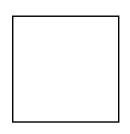
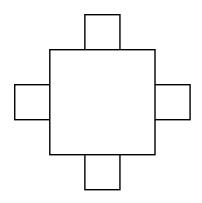
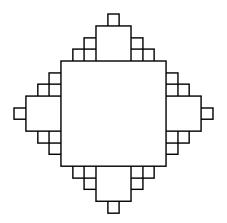
Number of segments:
Length of each segment:
Perimeter of shape:
Squares added:
Area of total figure:
Use your formulae to answer
these specific questions.
1.
What is the area of the
fractal after the 3rd iteration?
2.
What is the perimeter
of the fractal after the 4th iteration?
3.
What do you think
happens to the perimeter of the fractal as n increases without
bound?
4.
Does the area behave in
the same way? Give evidence to support
your answer.
Write a description of how
the fractal is created.
Part II
Consider this triangular
fractal. Analyze it as you did the fractals
in the exploration activity. Write the
following formulae in terms of n, where n is the
number of iterations completed:
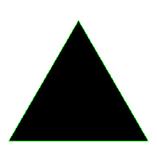
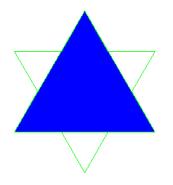

Number of segments:
Length of each segment:
Perimeter of shape:
Triangles added:
Area of total figure:
Use your formulae to answer
these specific questions.
5.
What is the area of the
fractal after the 8th
iteration?
6.
What is the perimeter
of the fractal after the 10th iteration?
7.
What do you think
happens to the perimeter of the fractal as n increases without
bound?
8.
Does the area behave in
the same way? Give evidence to support
your answer.
Write a description of how
the fractal is created.
Extension
Fractal
geometry is a branch of chaos theory, which can be used to describe natural
phenomena. Traditionally, it has been
thought that some patterns are impossible to describe through mathematical
modeling. One area in which we found
these “impossible” patterns is geography.
However, this new (when you consider the history of math) branch of
mathematics has proven tradition wrong!
A photograph from space of mountain foothills might have fractal
self-similarity. The coastline of a
island can be modeled with fractals.
This extended assignment focuses on a chaos game. Almost everyone loves to play games, so
let’s see how chaos theory works in relation to fractals.
THE GAME: Chaos
First
draw an equilateral triangle on a piece of paper. Label the vertices of the triangle T, R, and L to represent top,
right, and left. Choose any point x in
the interior of the triangle as the starting point. Roll a die to choose T, R, or L at random. Then plot the point that is half way to the
vertex that has been selected. Continue
to roll a die to choose vertices and plot points.
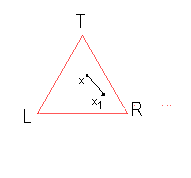
Do
you see a pattern? Probably not at first!
Could a random selection of points produce anything? Why not let modern technology serve as a
tool in helping you answer that question.
You can program a graphing calculator to play the game of chaos with the
following directions.
The following program generates 3000
points in a chaos game. (Much easier
than playing chaos by hand!)
PROGRAM: SIERPINS
:FnOff :If
1/3<N and N£2/3
:Clrdraw :Then
PlotsOff :.5(.5+X)àX
:AxesOff :.5(1+Y)àY
:0àXmin: 1àXmax :End
:0àymin: 1àymax :If
2/3<N
:randàX: randàY :Then
For
(K, 1, 3000) :.5(1+X)àX
randàN :.5YàY
:If
N£1/3 :End
:Then :Pt-On
(X, Y)
:.5XàX :End
:.5YàY :StorePic
6
:End
Describe
the pattern produced by this game.
Do
you think this pattern might be a fractal?
Explain.
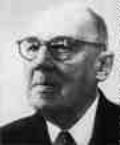
Compare
the picture generated by the above program with the sketches below. These sketches illustrate a fractal called
the Sierpinski’s triangle. It was named
after the Polish mathematician Waclaw Sierpinski who introduced it in
1916.
Describe
a recursive process to draw the Sierpinski Triangle.
